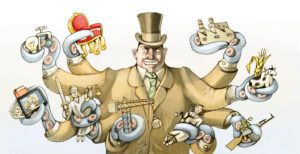|
To see long excerpts from “Capital in the Twenty-First Century” at Google Books, click here.
|
“Capital in the Twenty-First Century”
A book by Thomas Piketty. Translated from the French by Arthur Goldhammer
Just when you thought Karl Marx had finally lost all political and economic relevance, a brilliant French economist has come along to pick up where the German philosopher left off — correcting for many of Marx’s mistakes, updating his analysis in light of subsequent experience and unearthing a bounty of modern economic data to support a theory about capitalism’s inherent and self-destructive contradictions.
The economist is Thomas Piketty, a professor at the Paris School of Economics, who with Emmanuel Saez of the University of California at Berkeley has recently turbocharged the debate about income inequality. Piketty and Saez gathered data from tax returns that confirm the story of stagnant middle-class incomes over the last 30 years while revealing how much the super-rich have pulled away from everyone else.
In its magisterial sweep and ambition, Piketty’s latest work, “Capital in the Twenty-First Century,” is clearly modeled after Marx’s “Das Kapital.” But where Marx’s research was spotty, Piketty’s is prodigious. And where Marx foresaw capitalism’s collapse leading to a utopian proletariat paradise, Piketty sees a future of slow growth and Gilded Age disparities in which the wealthy — owners of capital — capture a steadily larger share of global wealth and income.
“The clash of communism and capitalism sterilized rather than stimulated research on capital and inequality by historians, economists, and even philosophers,” writes Piketty, who sets out to reignite a richer and more satisfying debate.
The quest for a unifying theory on the nature of capitalism began with the earliest political economists. Rev. Thomas Malthus theorized that population growth would keep the bulk of mankind trapped in misery and poverty, as was indeed the case for much of human history. David Ricardo theorized that the landed gentry would become ever more wealthy as the value of a fixed amount of land rose relative to the expanding supply of other goods. And Marx predicted that ruinous competition among workers and investors would inevitably drive wages to subsistence levels and investment returns to zeros, concentrating wealth in fewer and fewer hands.
We now know that what each of these determinist theories failed to anticipate was an explosion of productivity driven by new technology that allowed society to escape from the dystopic futures they imagined. But Piketty, marshaling an impressive array of data going back centuries, argues that the underlying mechanisms of capitalism are likely to reassert themselves, once again generating “arbitrary and unsustainable inequalities that radically undermine the meritocratic values on which democratic societies are based.”
In Piketty’s telling, it was only the unique set of circumstances between 1930 and 1975 that allowed capitalism’s natural drift toward inequality to be reversed. These unique circumstances included two world wars, a global depression and an outbreak of debt-fueled recession, all of which conspired to destroy vast amounts of wealth. Those years also ushered in government economic policies that consciously set out to redistribute income and economic power while spreading the latest technology to developing countries. Rapid growth in economic output in much of the world reduced the importance of inherited wealth and created a vast new global middle class with wealth of its own.
It was at the height of that “golden era” that economist Simon Kuznets — the father of GDP accounting — put forward the notion that as countries moved through various stages of development, household incomes would eventually become more equal. But Piketty lays out the case that the “Kuznets curve” was merely a fairytale told by Americans and Europeans to convince developing countries in the capitalist fold. And once inflation and population growth began to slow in the industrialized world in the 1970s, and economic growth returned to more normal levels, capitalism’s natural tendency toward inequality of wealth and income began to reassert itself.
Piketty’s prediction of a 21st century of slow growth and extreme inequality is based on historic data and a simple equation. The data, which he assembled with various collaborators in several countries, shows that over long periods of time, output per person — productivity — tends to grow at an average of 1 to 1.5 percent. The data also shows that average return on investment over long periods of time ranges between 4 and 5 percent.
The problem with these two historic trends, explains Piketty, is that whenever the return on financial capital (investment) is higher than the return on human capital (productivity) for an extended period, it is a matter of simple arithmetic that growing inequality will result. The reason: Those with highest incomes will save and invest, generating capital income that will allow them to pull away from those relying solely on wages and salaries. It only takes a few generations before this accumulating and accumulated wealth becomes a dominant factor in the economy and the social and political structure. Indeed, says Piketty, the data show it has already happened in the United States, where the inequality in the distribution of both wealth and income surpasses that of class-bound Europe of 1900.Part of that American story, writes Piketty, reflects the surge in pay for corporate executives and Wall St. financiers who make up a large part of the top 1 percent of income earners. As Piketty sees it, their soaring compensation cannot be adequately explained simply by superior education or performance, but also reflect imperfectly competitive labor and product markets that allow the top 1 percent to extract way more than their real economic contribution. The wealthy, Piketty says, are also in a position to take more risk with their savings while having access to the best investment and hedge fund managers, allowing them to earn a higher return than middle-class savers. And unlike middle-class savers, they are likely to re-invest their investment income each year rather than spend it. Combine those higher-than-average returns with the magic of compounding and you begin to understand how a rigid class structure can begin to take hold.
Indeed, one of the more delightful touches that Piketty brings to his task is how he draws on the novels of Honore de Balzac, Jane Austen and Henry James to illustrate the economics of a rigidly stratified society built on a foundation of accumulated capital. But even these literary forays are buttressed by incredibly detailed data on the size and flow of inheritances in France and England over the last two centuries. The creative use that Piketty makes of this historical information is as impressive as the painstaking work he did in collecting it.
Although Piketty’s prose is clear and compelling and translated artfully into plain English by Arthur Goldhammer, this is a book aimed more at other economists than general readers. At 577 pages of text, and 75 pages of footnotes, it is annoyingly repetitious at times. Long discourses on topics such as inflation and the current euro crisis add little to his central thesis, while Piketty spends way too much time on tedious explanations of minor cross-country differences in economic history. Like Marx, he would have benefited from an editor with a sharper pencil.
In the end, Piketty’s analysis of the past is more impressive than his predictions for the future are convincing. He fails to adequately explain how the accumulation of so much capital looking for good investment opportunities won’t eventually drive down returns, as economic theory would suggest. And like the grand theorists before him, he too easily dismisses the possibility of a burst in technology-induced productivity that could usher in another extended period of above-average growth in output and average incomes. “If one truly wishes to found a more just and rational social order,” he warns, “it is not enough to count on the caprices of technology.”
Moreover, unlike the 19th century, where real estate and government bonds were the primary form of capital, it is riskier assets that generate most of the wealth in the modern global economy — assets that can more quickly lose value as a result of changes in technology or global competition.
Nor is it clear, as Piketty asserts, that the only way to avoid a future of slow growth and extreme inequality is through confiscatory taxation. His prescription is an annual global wealth tax of up to 2 percent combined with progressive income tax rates that run as high as 80 percent. Yet as he himself acknowledges, the “golden years” were golden because of a complex interplay among laws, regulations, taxes and other restraints on corporate power. If confronted with unacceptable levels of inequality, why would democratic societies in the future be unable or unwilling to formulate a similar set of institutional restraints on capitalism?
For all its faults, however, Piketty’s “Capital in the Twenty-First Century” is an intellectual tour de force, a triumph of economic history over the theoretical, mathematical modeling that has come to dominate the economics profession in recent years. Piketty offers a timely and well-reasoned reminder that there is nothing inevitable about the dominance of human capital over financial capital, and that there is inherent in the dynamics of capitalism a natural and destabilizing tendency toward inequality of income, wealth and opportunity.
Steven Pearlstein is a Washington Post business and economics columnist and the Robinson Professor of Public and International Affairs at George Mason University.
©Washington Post Book World Service/Washington Post Writers Group







You need to be a supporter to comment.
There are currently no responses to this article.
Be the first to respond.